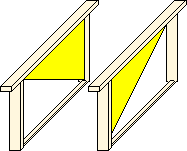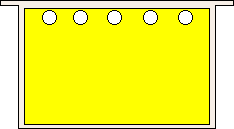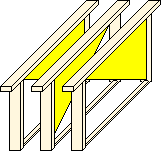If we have collected our swarm, then it is prudent to take any possible measures to make sure it does not abscond from the hive that we place it in. When a swarm issues from a hive it has already decided where it will make it's home and it isn't your hive. The chances a swarm will abscond from a hive it is put in by a beekeeper is quite high, probably 50:50.
The arrangement of frames in a hive that is intended to house a swarm, may have a bearing on this and there are subtle differences that can be employed at different times of day.

Frames with foundation are often recommended for hiving swarms... This mimics a natural swarm which would have to build all of its comb from scratch. A variation on this theme is narrow strips or starter strips of foundation and I have had good success using triangular foundation for the central group of frames. The illustration at right shows frames fitted with foundation that have been cut from corner to corner.
Old comb is attractive to bees and will have defects that the bees will set to and correct, which keeps some of the bees 'busy' and makes them less likely to depart from their new home.
Fresh drawn comb is not as attractive, but may have defects for the bees to work on.
The ratio of the types of frame that should be used will be tempered by what is actually available. My own preference is that more than 50% of the frames should be full sheets of foundation with any old or drawn combs in the centre of the box. I like to employ used frames to provide a focus for the bees activity, if I am performing the hiving early in the afternoon... I will sometimes include a frame of brood to act as a 'magnet'. (If you know the colony the swarm came from I haven't a problem with using comb, but if it is a stray swarm I think it is bad practice to do so. Although the chance of the swarm being infected with foul brood is very small, there is still a chance. For the same reason I wouldn't feed it either. I have never given a frame of brood to a swarm myself, but I know several who have and the swarm has still absconded. It seems the lure of their previously chosen home is greater than the pheromones given off by the brood. I advise against this practise. R.P.)
If it is late in the evening then I prefer to use frames with starters or diagonally cut foundation in the central region. If I have to use a full compliment of frames with full sheets of foundation then I will poke a few holes in the foundation of the central four frames. I make the holes close to the top bar and about finger diameter (an apple corer with sharpened edges is an ideal tool for this purpose).

What! Poke holes in new foundation? Is the indignant question that often follows my statement, but it is good for various reasons and actually speeds up the process of comb drawing.
The holes allow the clustering bees to communicate with one another which gives them a more stable sense of community, it also allows easy passage, at several points, for bees to traverse from one side of the growing comb to the other.

A group of frames fitted with starter strips also allows this communication as the bees will cluster on the top bars and starters and hang below the edges of the strips.

If diagonally cut sheets of foundation are used then the frames are placed with the triangles alternating, which will give a similar easy passage around the edges of the foundation and has the most open space in the centre of the group.
(Although the cutting of foundation may seem unnecessary I think it has merits. When bees build comb naturally they cluster underneath the comb to build downwards, but when we give them foundation they have to cluster on the side. I think many beekeepers may find cutting foundation away from the wires fiddly and this method may better suit frames and foundation that are horizontally wired. R.P.)
A disadvantage of using comb of any description is that honey will be disgorged by bees more rapidly than would be the case if no cells are available. This honey may not be fully consumed and may be added to honey gathered in the first few days. Thus any disease spores are not fully consumed in wax making and may lurk in the honey to cause problems when ingested and fed to larvae.
I have also used an arrangement whereby the outer two, three or four frames were drawn or old comb. The central three or four frames were starter strips and the remaining spaces were full sheets of foundation. The logic here is the bees will preferentially cluster at the central region where they can maintain contact. There will be travelling activity between this cluster and the outer drawn frames and this travel imparts pheromones to the intervening sheets of foundation which speeds up the utilisation and drawing of these frames.
Although the above may have suited Dave Cushman who was a perfectionist, I think it may be more than the ordinary beekeeper who has had a call to collect a swarm would want to bother with. I would suggest clipping the queen's wing or using a queen includer. Hive on foundation and don't feed. R.P.
Original material by Dave Cushman. Edited and additional material by Roger Patterson.
Page created pre-2011
Page updated 17/11/2022